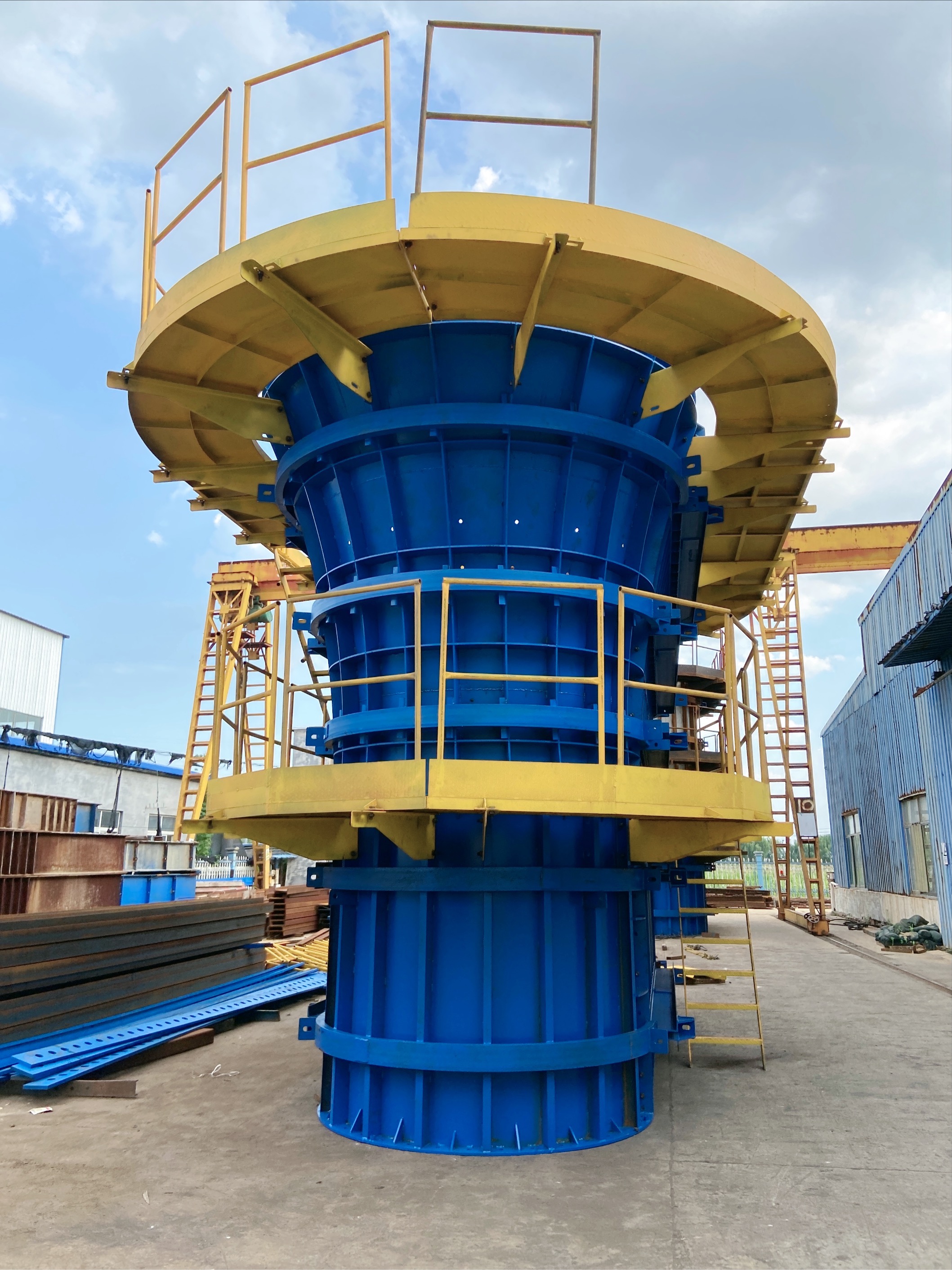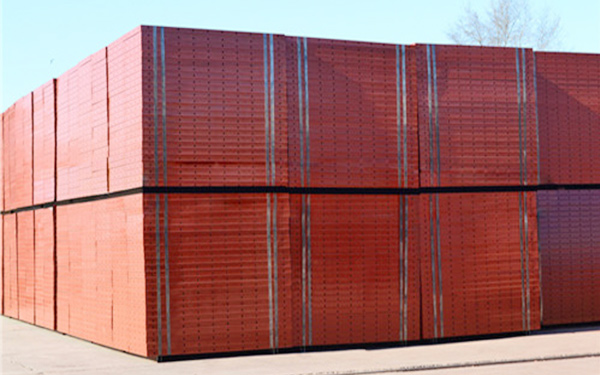Current position:
Home
News home
Industry News
Nearby steel formwork rental station: How to deal with and prevent honeycomb and pockmarks on steel formwork?
Nearby steel formwork rental station: How to deal with and prevent honeycomb and pockmarks on steel formwork?
source:Shandong Tianhong Heavy Industry Co., Ltd
Abstract:
The honeycomb and rough surface problems that occur during steel formwork construction can seriously affect the appearance quality and durability of concrete structures, and require systematic prevention and repair from multiple aspects such as design, construction, and materials. The following is a detailed plan for handling and prevention:
1、 Analysis of the Causes of Honeycomb Hemp Surface
Template related factors
Corrosion or residual concrete slag on the surface of steel formwork, resulting in rough surface after demolding;
Uneven or missed application of release agent, concrete bonding formwork;
The template joints are not tight and there is leakage of grout, resulting in local voids.
Concrete issues
Excessive collapse (>180mm) and segregation of aggregates;
Improper mix proportion (low sand ratio or insufficient rubber material) results in poor encapsulation of the slurry.
Improper construction operation
Insufficient vibration (bubbles not expelled) or excessive vibration (slurry floating);
Excessive pouring height (>2m) leads to aggregate separation.
2、 Preventive measures: Full process control
1. Template processing and maintenance
Surface cleaning:
Before each use, use a grinding machine to polish the surface of the template, remove rust and residual slurry, and ensure a smooth finish (Ra ≤ 3.2 μ m).
Selection of release agent:
Precautions for Applicable Scenarios of Release Agent Types
Oil based release agent is applied evenly to regular concrete to avoid color difference caused by oil accumulation
Water based release agent diluted 1:3 in plain concrete, sprayed twice
Resin based release agents for high-precision decorative concrete have high costs and require professional equipment for spraying
Joint sealing:
Paste 5mm thick sponge rubber strip at the template joint, and add L-shaped grout stopping angle steel at the corner.
2. Optimization of concrete mix proportion
Control slump: Adjust slump according to different structures (wall and column 120-160mm, beam and slab 140-180mm);
Adjust aggregate grading: increase the proportion of fine aggregates from 0.3~1.0mm to 15%~20% to improve the wrapping of the slurry;
Admixture: Add water reducing agent (water reduction rate ≥ 20%) or air entraining agent (gas content 4%~6%) to reduce bubbles.
3. Construction process improvement
Layered pouring: Each layer has a thickness of ≤ 500mm, and the wall adopts the "segmented pouring method" to reduce cold joints;
Standardized vibration:
Insertion vibrator with "fast insertion and slow extraction", spacing ≤ 400mm, 150-200mm away from the template;
The surface vibrator assists in surface finishing and eliminates bubbles at the top;
Control the pouring height: When it exceeds 2 meters, use a tumbling barrel or chute to prevent segregation.
3、 Classification treatment scheme for honeycomb hemp surface
1. Slightly rough surface (area<0.1 ㎡, depth ≤ 5mm)
Surface repair:
1) Rinse with clean water → 2) Brush cement paste (water cement ratio 0.4) → 3) Scrape polymer mortar (1:2 cement mortar+5% adhesive powder) → 4) Cover and cure.
Color difference treatment: Spray concrete color difference repair agent to maintain consistent appearance.
2. Moderate honeycomb (area 0.1~0.5 ㎡, depth 5~20mm)
Chiseling and repairing:
1) Chisel to dense layer → 2) Apply interface agent → 3) Layer by layer fill high-strength repair mortar (compressive strength ≥ 40MPa) → 4) Cover with film and cure for 7 days.
Case: Steel wire mesh can be added to the honeycomb at the bottom of the beam to enhance crack resistance.
3. Severe voids (area>0.5 ㎡, depth>20mm or exposed reinforcement)
Structural reinforcement:
1) Removing loose concrete → 2) Rust removal of steel bars → 3) Pouring C45 micro expansion concrete with formwork → 4) Testing strength after formwork removal;
5) If necessary, wrap it with carbon fiber cloth or steel plate (Figure 1).
Schematic diagram of carbon fiber reinforcement
4、 Typical Case Handling
Problem description and handling plan for engineering scenarios
The surface of the bridge pier has dense pores on the rough surface, with a depth of 3-5mm sandblasting treatment+epoxy mortar repair, and sprayed with transparent protective agent
The honeycomb depth of the exposed reinforcement at the bottom of the factory beam is 30mm, and the main reinforcement is chiseled out to a solid surface → additional reinforcement is welded → UHPC is poured for formwork support
The hollow area at the root of the shear wall is 0.8 square meters, and it is reinforced by pressure grouting (epoxy resin) with 1/3 of the thickness of the through wall and steel bonding on the outer side
5、 Long term management suggestions
Intelligent monitoring:
Using ultrasonic testing equipment to predict internal defects in concrete;
Drone inspection template sealing, AI identifies potential leakage points.
Standardization of processes:
Develop the "Quality Control Manual for Steel Formwork Concrete Appearance" to clarify the operating standards for each link;
Implement the "first piece acceptance system", where the first component is accepted and qualified before mass construction.
Personnel training:
Regularly organize skill competitions for vibration workers to strengthen muscle memory for "fast insertion and slow extraction" operations;
Specialized training for template workers on joint sealing and release agent spraying techniques.
summarize
The prevention and control of honeycomb and rough surface in steel formwork should adhere to the principles of "source control, fine process, and graded repair":
Prevention: Eliminate defect causes through fine template processing, optimization of concrete performance, and standardized vibration;
Handling: Choose surface repair or structural reinforcement based on the degree of defect, prioritizing durability;
Upgrade: Integrating intelligent detection with new materials such as UHPC to achieve the goal of "zero defects".
Template related factors
Corrosion or residual concrete slag on the surface of steel formwork, resulting in rough surface after demolding;
Uneven or missed application of release agent, concrete bonding formwork;
The template joints are not tight and there is leakage of grout, resulting in local voids.
Concrete issues
Excessive collapse (>180mm) and segregation of aggregates;
Improper mix proportion (low sand ratio or insufficient rubber material) results in poor encapsulation of the slurry.
Improper construction operation
Insufficient vibration (bubbles not expelled) or excessive vibration (slurry floating);
Excessive pouring height (>2m) leads to aggregate separation.
2、 Preventive measures: Full process control
1. Template processing and maintenance
Surface cleaning:
Before each use, use a grinding machine to polish the surface of the template, remove rust and residual slurry, and ensure a smooth finish (Ra ≤ 3.2 μ m).
Selection of release agent:
Precautions for Applicable Scenarios of Release Agent Types
Oil based release agent is applied evenly to regular concrete to avoid color difference caused by oil accumulation
Water based release agent diluted 1:3 in plain concrete, sprayed twice
Resin based release agents for high-precision decorative concrete have high costs and require professional equipment for spraying
Joint sealing:
Paste 5mm thick sponge rubber strip at the template joint, and add L-shaped grout stopping angle steel at the corner.
2. Optimization of concrete mix proportion
Control slump: Adjust slump according to different structures (wall and column 120-160mm, beam and slab 140-180mm);
Adjust aggregate grading: increase the proportion of fine aggregates from 0.3~1.0mm to 15%~20% to improve the wrapping of the slurry;
Admixture: Add water reducing agent (water reduction rate ≥ 20%) or air entraining agent (gas content 4%~6%) to reduce bubbles.
3. Construction process improvement
Layered pouring: Each layer has a thickness of ≤ 500mm, and the wall adopts the "segmented pouring method" to reduce cold joints;
Standardized vibration:
Insertion vibrator with "fast insertion and slow extraction", spacing ≤ 400mm, 150-200mm away from the template;
The surface vibrator assists in surface finishing and eliminates bubbles at the top;
Control the pouring height: When it exceeds 2 meters, use a tumbling barrel or chute to prevent segregation.
3、 Classification treatment scheme for honeycomb hemp surface
1. Slightly rough surface (area<0.1 ㎡, depth ≤ 5mm)
Surface repair:
1) Rinse with clean water → 2) Brush cement paste (water cement ratio 0.4) → 3) Scrape polymer mortar (1:2 cement mortar+5% adhesive powder) → 4) Cover and cure.
Color difference treatment: Spray concrete color difference repair agent to maintain consistent appearance.
2. Moderate honeycomb (area 0.1~0.5 ㎡, depth 5~20mm)
Chiseling and repairing:
1) Chisel to dense layer → 2) Apply interface agent → 3) Layer by layer fill high-strength repair mortar (compressive strength ≥ 40MPa) → 4) Cover with film and cure for 7 days.
Case: Steel wire mesh can be added to the honeycomb at the bottom of the beam to enhance crack resistance.
3. Severe voids (area>0.5 ㎡, depth>20mm or exposed reinforcement)
Structural reinforcement:
1) Removing loose concrete → 2) Rust removal of steel bars → 3) Pouring C45 micro expansion concrete with formwork → 4) Testing strength after formwork removal;
5) If necessary, wrap it with carbon fiber cloth or steel plate (Figure 1).
Schematic diagram of carbon fiber reinforcement
4、 Typical Case Handling
Problem description and handling plan for engineering scenarios
The surface of the bridge pier has dense pores on the rough surface, with a depth of 3-5mm sandblasting treatment+epoxy mortar repair, and sprayed with transparent protective agent
The honeycomb depth of the exposed reinforcement at the bottom of the factory beam is 30mm, and the main reinforcement is chiseled out to a solid surface → additional reinforcement is welded → UHPC is poured for formwork support
The hollow area at the root of the shear wall is 0.8 square meters, and it is reinforced by pressure grouting (epoxy resin) with 1/3 of the thickness of the through wall and steel bonding on the outer side
5、 Long term management suggestions
Intelligent monitoring:
Using ultrasonic testing equipment to predict internal defects in concrete;
Drone inspection template sealing, AI identifies potential leakage points.
Standardization of processes:
Develop the "Quality Control Manual for Steel Formwork Concrete Appearance" to clarify the operating standards for each link;
Implement the "first piece acceptance system", where the first component is accepted and qualified before mass construction.
Personnel training:
Regularly organize skill competitions for vibration workers to strengthen muscle memory for "fast insertion and slow extraction" operations;
Specialized training for template workers on joint sealing and release agent spraying techniques.
summarize
The prevention and control of honeycomb and rough surface in steel formwork should adhere to the principles of "source control, fine process, and graded repair":
Prevention: Eliminate defect causes through fine template processing, optimization of concrete performance, and standardized vibration;
Handling: Choose surface repair or structural reinforcement based on the degree of defect, prioritizing durability;
Upgrade: Integrating intelligent detection with new materials such as UHPC to achieve the goal of "zero defects".
Disclaimer: The content provided on this website is for reference only (some information is sourced from the internet). The publication of content information is for the purpose of transmission and does not represent the views of this website. If the content involves copyright issues, please contact the website editor in a timely manner, and we will take appropriate measures to avoid unnecessary losses for both parties.
Related article
- Customization of steel formwork specifications: What are the installation steps for steel formwork?
- Processing custom steel formwork factory: About rust prevention treatment methods and precautions for steel formwork
- Template manufacturer: What are the specific risks of grout leakage to construction safety?
- Steel template manufacturers, wholesalers, and suppliers: What should be done if there are scratches on the surface of the template?
- Renting steel formwork: What is the price of steel formwork?
- Manufacturer of standardized steel formwork: How much impact does leakage of formwork joints have on structural safety?
- Bridge anti-collision guardrail steel formwork: What are the common methods for correcting steel formwork?
- Manufacturers of composite steel formwork: How to evaluate the corrosion rate of the formwork?
- Customized processing of bridge steel formwork: how to prevent and deal with unstable formwork support?
- Steel formwork manufacturer: How long is the lifespan of stainless steel formwork?
- Composite steel formwork manufacturer supply: How to calculate the area of steel formwork?
- Renting steel formwork manufacturers: How much does the material of steel formwork affect the price?
Hot article

- T梁模版
- Pulling out Mountains and Rivers for Win Win - Jining Tianli Employees Celebrate National Day Holiday with Tug of War Competition
- 力“拔”山兮,“河”作共赢——济宁天力员工欢度国庆假期之拔河比赛
- Pulling out Mountains and Rivers for Win Win - Jining Tianli Employees Celebrate National Day Holiday with Tug of War Competition
- Pulling out Mountains and Rivers for Win Win - Jining Tianli Employees Celebrate National Day Holiday with Tug of War Competition
- Pulling out Mountains and Rivers for Win Win - Jining Tianli Employees Celebrate National Day Holiday with Tug of War Competition
- Pulling out Mountains and Rivers for Win Win - Jining Tianli Employees Celebrate National Day Holiday with Tug of War Competition
Recommended article

Customized rental of construction steel formwork: How to prevent and deal with loose joints in steel formwork?

Customized rental of steel formwork: What are the dimensions, specifications, and models of steel formwork?
- Customized rental of construction steel formwork: How to prevent and deal with loose joints in steel formwork?
- Customized rental of steel formwork: What are the dimensions, specifications, and models of steel formwork?
- Steel formwork manufacturer supply specifications: What are the applicable fields for steel formwork
- 力“拔”山兮,“河”作共赢——济宁天力员工欢度国庆假期之拔河比赛
- Pulling out Mountains and Rivers for Win Win - Jining Tianli Employees Celebrate National Day Holiday with Tug of War Competition
- Pulling out Mountains and Rivers for Win Win - Jining Tianli Employees Celebrate National Day Holiday with Tug of War Competition
- Pulling out Mountains and Rivers for Win Win - Jining Tianli Employees Celebrate National Day Holiday with Tug of War Competition
- Pulling out Mountains and Rivers for Win Win - Jining Tianli Employees Celebrate National Day Holiday with Tug of War Competition



